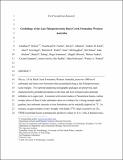Geobiology of the late Paleoproterozoic Duck Creek Formation, Western Australia
Author(s)
Wilson, Jonathan P.; Fischer, Woodward W.; Johnston, David T.; Knoll, Andrew H.; Grotzinger, John P.; Walter, Malcolm R.; McNaughton, Neal J.; Simon, Mel; Abelson, John; Schrag, Daniel P.; Allwood, Abigail; Andres, Miriam; Gammon, Crystal; Garvin, Jessica; Rashby, Sky; Schweizer, Maia; Summons, Roger E; Watters, Wesley A.; ... Show more Show less
Downloadknoll_duckcreek.pdf (2.353Mb)
PUBLISHER_CC
Publisher with Creative Commons License
Creative Commons Attribution
Terms of use
Metadata
Show full item recordAbstract
The ca. 1.8 Ga Duck Creek Formation, Western Australia, preserves 1000 m of carbonates and minor iron formation that accumulated along a late Paleoproterozoic ocean margin. Two upward-deepening stratigraphic packages are preserved, each characterized by peritidal precipitates at the base and iron formation and carbonate turbidites in its upper part. Consistent with recent studies of Neoarchean basins, carbon isotope ratios of Duck Creek carbonates show no evidence for a strong isotopic depth gradient, but carbonate minerals in iron formations can be markedly depleted in [superscript 13]C. In contrast, oxygen isotopes covary strongly with depth; delta[superscript 18]O values as positive as 2%. VPDB in peritidal facies systematically decline to values of 6 to 16% in basinal rocks, reflecting, we posit, the timing of diagenetic closure. The Duck Creek Formation contains microfossils similar to those of the Gunflint Formation, Canada; they are restricted to early diagenetic cherts developed in basinal facies, strengthening the hypothesis that such fossils capture communities driven by iron metabolism. Indeed, X-ray diffraction data indicate that the Duck Creek basin was ferruginous throughout its history. The persistence of ferruginous waters and iron formation deposition in Western Australia for at least several tens of millions of years after the transition to sulfidic conditions in Laurentia suggests that the late Paleoproterozoic expansion of sulfidic subsurface waters was globally asynchronous.
Date issued
2010-03Department
Massachusetts Institute of Technology. Department of Earth, Atmospheric, and Planetary SciencesJournal
Precambrian Research
Publisher
Elsevier BV
Citation
Wilson, Jonathan P., et al. “Geobiology of the Late Paleoproterozoic Duck Creek Formation, Western Australia.” Precambrian Research, vol. 179, no. 1–4, May 2010, pp. 135–49.
Version: Author's final manuscript
ISSN
0301-9268